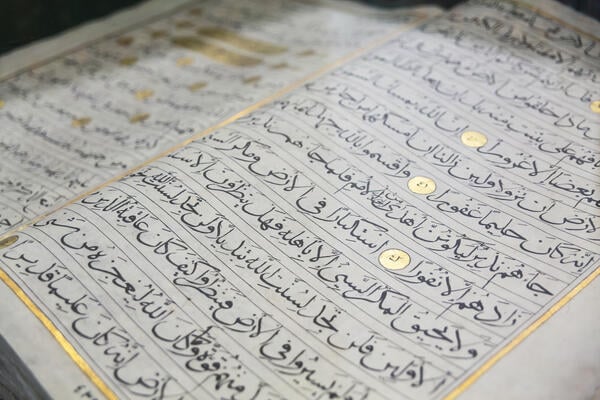
Thoughts on 20-Plus Years of Teaching Islam (opinion)
When I first began teaching Islam, there was no road map. In 2001, I was a visiting assistant professor of Islamic and Middle Eastern studies at the University of Iowa—the first full-time professor of Islam in the history of the state. I was in my 20s, still finishing my dissertation, when the attacks of Sept. 11 unfolded. Suddenly, I found myself trying to explain a 1,400-year-old religion to students who had watched the Twin Towers fall on live television.
Teaching Islam in American universities has never been more widespread, more diverse or more embattled. That is the story of the past two decades: a field that has grown dramatically, transformed in terms of who teaches it, and now finds itself under intensifying political scrutiny.
That experience in Iowa shaped everything that came after. I discovered that my task was not only to introduce students to the theological, historical and cultural breadth of Islam but also to help them unlearn the simplistic caricatures they had absorbed from media and politics. Islam was not a monolith. It was not synonymous with terror. It was, like Christianity or Judaism, a faith defined by argument, diversity and adaptation.
Those class lectures eventually became the foundation for No god but God: The Origins, Evolution and Future of Islam, first published in 2005. I hoped the book would serve both general readers and university classrooms. To my surprise, it quickly became a popular text for teaching Islam in the United States and far beyond. It has been translated into dozens of languages, adopted in seminaries and world religion courses, and read in mosques, churches and synagogues.
Two decades later, the landscape of Islamic studies in American universities looks profoundly different. In 2001, very few institutions offered dedicated courses on Islam outside of theology departments. Today, there are hundreds of such courses, spanning history, political science, gender studies and literature. The proliferation has been remarkable—though uneven. Some courses are rigorous, rooted in language and text, while others are more ad hoc, responding to student demand and global events.
Another profound shift has been in who is teaching Islam. For most of the modern history of religious studies in America, Christian professors taught Christianity, Jewish professors taught Judaism—but it was rare to find Muslim professors teaching Islam. In nearly two decades of studying the subject, I had only one Muslim professor. That has changed dramatically. Today, Muslim scholars occupy faculty positions across the country, and new professional associations—such as the International Quranic Studies Association, of which I am a member—are fostering networks of Muslim academics who bring both scholarly expertise and lived experience into the classroom. This diversification has expanded the kinds of questions and perspectives that shape the field, though it has also forced universities to confront new debates over authority, representation and bias.
Meanwhile, the teaching of Islam—like so many fields in the humanities—is now buffeted by unprecedented political pressure. Across the country, state governments have moved to limit what can and cannot be taught in universities and ban diversity, equity and inclusion programs. More recently, elite universities such as Columbia and Harvard have faced political scrutiny from the Trump administration and Congress into their Middle East studies programs, accused by some lawmakers of being biased. In today’s climate, teaching Islam can feel like an act of defiance. Professors often self-censor, conscious that a stray lecture note could trigger outside campaigns or even threats. The irony is that in a moment when greater understanding of Islam is needed more than ever, the very institutions best equipped to provide that education are being undermined.
Yet this is precisely why teaching Islam in universities matters more than ever. At a time when Islam has faded from the headlines but remains entangled in the debates that define our era—from authoritarianism to surveillance to religious pluralism—the classroom is one of the few places where the faith can be encountered on its own terms. The role of professors is not to sanitize or defend Islam, but to present it in all its richness, contradictions and ongoing transformations.
The fully updated 20th-anniversary edition of No god but God is my attempt to support that task for another generation of teachers and students. The new preface reflects on what has changed since 2005—the Arab Spring, the rise of digital Islam, the ebb of the “war on terror”—and what has not: Islam’s enduring struggle to reconcile tradition and modernity, authority and pluralism.
More than two decades of teaching have convinced me that education about Islam cannot be episodic, tied only to moments of crisis or headlines of violence. It must be sustained, interdisciplinary and grounded in serious scholarship. It must expand beyond political science courses on terrorism and foreign policy, and beyond theology seminars comparing sacred texts, into the wider humanities and social sciences. And it must center the lived experiences of Muslims themselves.
The classroom is not a mosque. But it is one of the few spaces where young people can confront their assumptions, wrestle with complexity, and imagine new ways of understanding the role of religion in the world. That was my conviction in 2001, when I walked into a lecture hall in Iowa just days after Sept. 11. It remains my conviction today.
The classroom may not be a mosque, but it remains one of the few places where Islam can be encountered in all its richness, contradictions and humanity.
Source link


